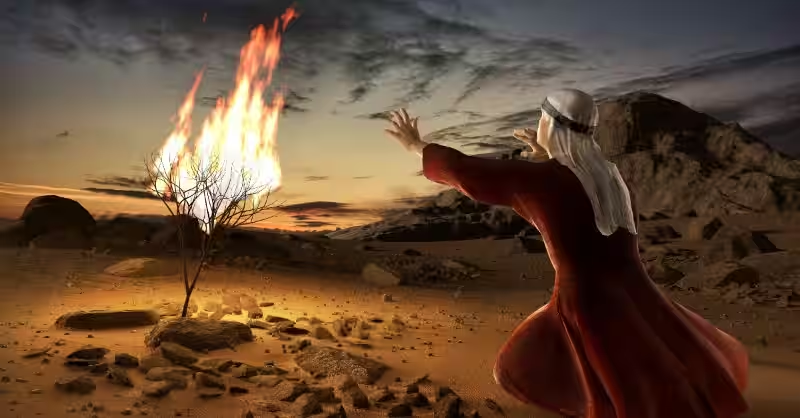What Does the Burning Bush Symbolize?

The burning bush, a seemingly simple image from the Book of Exodus, holds profound theological significance across various faiths. What does the burning bush symbolize? The answer is multifaceted, encompassing God's holiness, humanity's sinfulness, and the ultimate salvation offered through Jesus Christ. This seemingly simple image becomes a powerful lens through which to understand God's nature and humanity's relationship with the divine.
God’s Holiness and the Paradox of the Unconsumed Bush
The burning bush, described in Exodus 3, is a theophany – a visible manifestation of God. It appears to Moses on Mount Horeb, a holy place, ablaze with fire yet miraculously unconsumed. This paradoxical image immediately establishes the central theme: God's holiness. The fire symbolizes God's consuming power, His utter otherness, His transcendence beyond human comprehension. The fact that the bush isn't consumed, however, points to a further aspect of God's nature: His mercy.
This isn't a simple duality; it's a paradox. The burning bush vividly illustrates the tension between God's awesome power and his compassionate love. Moses, upon encountering this divine spectacle, immediately removes his sandals, overwhelmed by the holiness of the place. This act of reverence underscores the inherent awe and fear inspired by encountering the divine. The contrasting images of consuming fire and the unconsumed bush highlight the paradoxical nature of God. He is both terrifyingly holy and wonderfully merciful.
The Warning of Presumption
The consequences of approaching God presumptuously are starkly illustrated in the story of Aaron's sons, Nadab and Abihu. They offered unauthorized fire before the Lord and were consumed. Their deaths serve as a solemn warning: approaching God's holiness without proper reverence is deadly. This underscores the immense gap between the divine and the human, a gap that demands humility and respect. The burning bush, therefore, serves not only as a symbol of God's presence but also as a stark reminder of the dangers of approaching Him without the proper mediation.
The Burning Bush and the Incarnation of Christ
The very nature of the burning bush – a perishable thing untouched by consuming fire – foreshadows Christ. Wood, symbolizing human mortality and frailty, is untouched by the divine fire. This prefigures Jesus, who, as fully God and fully man, could endure the holiness of God without being consumed. He bridged the gap between the divine and the human, allowing humanity to approach God without fear of annihilation.
This comparison gains further strength when we consider the fiery furnace of Shadrach, Meshach, and Abednego in the Book of Daniel. Like the burning bush, the three men survived the intense heat, protected by a "fourth man," widely interpreted as a theophany of the pre-incarnate Christ. Their survival mirrors the unconsumed bush, highlighting the theme that only through faith in Jesus can humanity withstand God's judgment. The burning bush, therefore, becomes a symbol pointing towards the ultimate salvation found in Christ.
God's Mercy and the Sacrifice of Jesus
While God’s mercy is a central theme, it's not arbitrary. Lamentations 3:21-23 speaks of God's “lovingkindnesses” and reminds us that His compassions never fail. However, this mercy is not simply a capricious act but is made possible by the sacrifice of Jesus. Jesus's sacrifice provides the just payment for sins, bridging the chasm between God's justice and His mercy. Hebrews 4:14-16 emphasizes Jesus's role as a high priest, one who understands our weaknesses and offers access to God's grace. Only through faith in Jesus can we approach God's holy presence without being consumed. The burning bush thus symbolizes both God's judgment and His profound mercy, ultimately leading to the salvation offered in Christ.
The Burning Bush: A Symbol Across Faiths
The burning bush's symbolism extends beyond Christian interpretations. In Judaism, it represents God's covenant with His people, His promise of deliverance from oppression. The very act of God speaking to Moses from the bush signifies a direct communication, a profound revelation of God's presence and concern for the suffering Israelites. The revelation of the divine name, "I AM WHO I AM" (Yahweh), further emphasizes God's eternal existence and unwavering commitment to His people. The fire itself is a symbol of God's power and the impending liberation from slavery.
Islamic tradition also recounts a similar event, highlighting God’s call to Moses at Mount Tur. The Baháʼí Faith sees the burning bush as a recurring symbol of divine communication, interpreting Baháʼu’lláh's revelation as a continuation of God's voice. These varied interpretations demonstrate the enduring power and multifaceted meaning of the burning bush, a symbol that continues to resonate across faiths and throughout history. The burning bush, regardless of interpretation, speaks of a powerful encounter, a moment of divine revelation that fundamentally shapes the relationship between humanity and the divine. What does the burning bush symbolize? It symbolizes the paradox of God: holy, powerful, yet merciful and loving, a paradox ultimately resolved through faith in Jesus Christ.
Frequently Asked Questions: The Symbolism of the Burning Bush
What is the significance of the burning bush in Exodus 3?
The burning bush in Exodus 3 represents a theophany—a visible manifestation of God to Moses. This event, occurring on Mount Horeb, is profoundly significant for several reasons:
-
God's Holiness: The bush, ablaze yet unconsumed, symbolizes the paradoxical nature of God: holy and consuming, yet merciful and life-giving. It highlights the vast difference between the divine and the human, emphasizing God's transcendent holiness. The fire symbolizes God's purifying and refining nature.
-
God's Power and Glory: The burning bush is a terrifying yet awe-inspiring display of God's majesty. It foreshadows later manifestations of God's glory and reminds us of God's power during the Israelites' impending trials.
-
God's Mercy and Salvation: While the fire represents God's judgment, the unconsumed bush signifies His mercy and promise of deliverance for the Israelites. It marks the first time God refers to them as "my people," highlighting His concern for their suffering.
-
Revelation of God's Name: The burning bush is the context in which God reveals His name, "I AM WHO I AM" (Yahweh), emphasizing His eternal existence, self-sufficiency, and unchanging nature.
How does the burning bush relate to human sinfulness?
The burning bush serves as a stark reminder of human sinfulness and our inability to approach God's holiness directly. The fate of Aaron's sons, Nadab and Abihu, who perished for offering unauthorized fire, serves as a warning against presumptuous approaches to God. The perishable nature of the wood (representing human mortality) contrasts sharply with the divine, unconsumed bush.
What is the connection between the burning bush and Jesus Christ?
The burning bush foreshadows Jesus Christ, who, as fully God and fully man, could withstand God's holiness. The unconsumed bush parallels the fiery furnace of Shadrach, Meshach, and Abednego in Daniel 3, where the three men survived, protected by a "fourth man," interpreted as a theophany of the pre-incarnate Christ. This highlights that only through faith in Jesus can humans withstand God's judgment. Jesus' sacrifice makes God's mercy possible, ensuring just payment for sins, allowing believers to approach God with faith rather than fear.
Does the burning bush symbolize only judgment, or is there a message of mercy?
The burning bush symbolizes both God's judgment and His profound mercy. While the fire represents the consuming nature of God's holiness and the consequences of sin, the bush's survival signifies God's grace and willingness to act on behalf of His people. God's mercy, however, isn't arbitrary; it's made possible by Jesus' sacrifice, ensuring just payment for sins and providing access to God's grace through faith. This is emphasized in Hebrews 4:14-16, where Jesus is presented as a high priest who empathizes with human weaknesses.
Are there different interpretations of the burning bush across different faiths?
Yes, the burning bush holds diverse symbolic meanings across various faiths. In Judaism, it often represents God's protection of the Israelites. Christianity interprets it typologically, sometimes connecting it to the Virgin Mary. Islam recounts a similar event, emphasizing God's call to Moses. The Baháʼí Faith views it as a recurring symbol of divine communication. These varied interpretations underscore the enduring power and multifaceted symbolism of the burning bush narrative.








